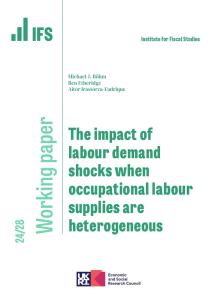Politicians often say they want to see income inequality or poverty fall. The most explicit current example of such an ambition is the set of targets in the 2010 Child Poverty Act. Meeting these would require large increases in the real incomes of low-income households with children, and a very substantial narrowing of the gap between these households and those on middle-incomes, by 2020-21.
Political and economic constraints mean that achieving these targets solely by using benefits and tax credits to redistribute to low-income households looks virtually impossible, particularly in the context of the Government’s plan to eliminate the budget deficit mostly through spending cuts (rather than tax rises). It is natural, therefore, to ask whether the targets could be hit by transforming the distribution of private income over the next eight years. With this in mind, research co-authored by us and published today considers the likely impact of changes in the mix of jobs over the rest of this decade on typical measures of income poverty and income inequality.
The research combined long-run projections of the state of the labour market produced by the Institute for Employment Research at the University of Warwick with a model of household incomes produced by the IFS. Our previous work had already suggested that relative poverty would rise between now and 2020, partly because, over the period as a whole, wages are likely to grow in real terms while income from benefits and tax credits will be pegged to inflation, and partly because of the cuts to welfare spending announced by this government. In our new research, we found that projected changes in the mix of job types (where “job types” are defined by industry, occupation, skill level, gender, region, and full-time or part-time status) over this decade are likely to widen inequalities in household incomes further, and will consequently cause measures of relative poverty to rise further too. This is mostly due to the anticipated continuation of long-running labour market trends: for example, high-wage occupations are expected to continue to replace middle-wage occupations, but with little change in the prevalence of low-wage occupations in a so-called “hollowing out” of the labour market.
We also looked at plausible alternative scenarios for the labour market. The scenarios held the total number of jobs in the economy fixed, but changed the sorts of jobs available, or the people working in these jobs, or the pay differentials between different sorts of jobs. Even scenarios which one might reasonably expect to reduce inequality and relative poverty often have surprisingly little overall impact on the income distribution. One reason for this is that many individuals on low pay do not live in households with a low income, usually because they live with other adults who are also earning, and this means that labour market trends which may help the low paid are not necessarily well-targeted on households with low incomes. For example, reducing the gender pay gap would benefit women in low-income households but would also benefit women in high-income households, with almost no net impact on income inequality or relative poverty. Of course, this is not to suggest that one should not be interested in narrowing the gender pay gap for reasons other than reducing household income inequalities, but it highlights that governments should be clear about which objectives are achieved by which policies. Another reason is that a relatively large fraction of households with low income do not have anyone in work. This constrains the extent to which labour market changes can reduce poverty or inequality, unless the total level of employment can be substantially increased.
Of course, it is impossible to account fully for everything which may affect the distribution of income, and there remain important unanswered questions. For example, the research did not consider the scope for training and skills policies to increase the total level of employment in the economy. We did allow for the direct effects of Universal Credit on household incomes, but did not consider how the associated changes to financial incentives and the requirements imposed upon recipients to look for better-paid work would affect incomes. But with relative child poverty projected to reach almost 26% in 2020-21 in our baseline scenario, there is no way that Universal Credit alone will get the Government back on track to hit its 2020 target of reducing this measure of poverty to just 10%.
This research adds to the evidence that policy-makers who want to reduce income inequalities in the coming years will have to swim against a rising tide of inequality-increasing changes in the mix of job types, and a less redistributive tax and benefit system. The targets for 2020-21 specified in the Child Poverty Act were always ambitious (requiring a lower rate of relative child poverty than the UK has experienced in the past 60 years), and it looks increasingly doubtful that anything could bring about the transformation required in the time available, given constraints such as the fact that many of the parents of 2020-21 have already left education. If the Government disagrees with this assessment, it needs to explain urgently and credibly how such a rapid and spectacular transformation is going to take place. The only other constructive way forward is surely for the Government to set itself different objectives which do reflect its view of what is both achievable and desirable. It is difficult to see the value of extremely ambitious targets without a credible plan for meeting them.









